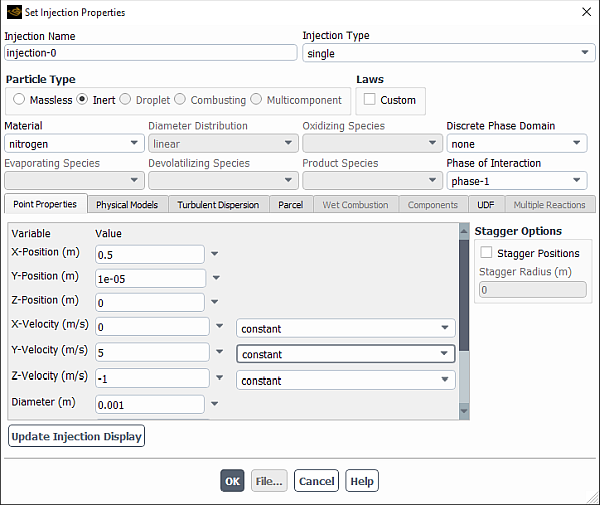When using the DPM in conjunction with the Eulerian multiphase model, you can track particles in an arbitrary Eulerian phase or in the mixture of all phases. The particles are one-way coupled with the continuous phase(s), so that only forces from the fluid phase are considered when computing the particle equation of motion, while the source terms arising from the dispersed phase are not considered in the fluid flow equation.
When particles are tracked in a single Eulerian phase, only forces from that phase are taken into account. In case of flow separation, the particles are not accelerated in regions within which the phase of interaction is not present. Body forces, such as gravitation, do not depend on the phase of interaction.
When particles are tracked in the mixture of all phases, the force contribution from each phase to the particle acceleration is weighted by the volume fraction of that phase.
The feature is available only for Massless and Inert particle types.
For particle tracking in all phases, you cannot specify the drag law per injection-phase pair. The drag law you select for the injection will be applied to all injection-phase interactions.
Within the DDPM framework, injections assigned to a DPM phase can interact only with the primary phase.
Particle turbulent dispersion is calculated from turbulent velocity fluctuations of the primary phase only. If the phase of interaction is not set to either a primary phase or all-phases, turbulent dispersion of particles is not accounted for.
Wall film particles interact only with the primary phase.
The following forces are not supported:
Forces arising in rotating frames of reference
Thermophoretic force
Brownian motion
Particle rotation is supported only for particle tracking in a single Eulerian phase.
Important: The particle integration using the trapezoidal numerical scheme is under development and is not yet suitable for use. Instead use the Eulerian implicit scheme.
Enable the beta feature access (as described in Introduction).
In the Fluent console, issue the following text command:
define/models/dpm/interaction/choice-of-eulerian-phase-for-interaction?Allow choice of an Eulerian phase (or the mixture of all) for the DPM interaction? [no]yesOnce this text command is issued, the Phase of Interaction drop-down list appears below the Discrete Phase Domain drop-down list in the Set Injection Properties dialog box.

Important: In releases prior to 2021 R2, the Phase of Interaction drop-down list was exposed by default after enabling beta features. This will be respected when a case created in those releases is read into Ansys Fluent 2021 R2 or later. However, if you do not use the particle tracking feature in your case, you should disable it to avoid any model incompatibilities by issuing the following text command:
define/models/dpm/interaction/choice-of-eulerian-phase-for-interaction?Allow choice of an Eulerian phase (or the mixture of all) for the DPM interaction? [yes]noFrom the Phase of Interaction drop-down list, select the phase in which particles will be tracked. If you want to track particles in all phases, select all-phases. The default phase of interaction is the primary phase.
If you want to change the phase of interaction for multiple injections, select Fluid-Particle Interaction from the Injection Setup selection list in the Set Multiple Injection Properties dialog box, and then select the appropriate phase from the Phase of Interaction drop-down list.

You can also set the phase of interaction in a multiphase flow using the following text command:
define/injections/properties/set/interaction/fluid-particle-interaction/phase-of-interaction
Note that this command is available only when you select the injection(s) using define/injections/properties/set/pick-injections-to-set.


